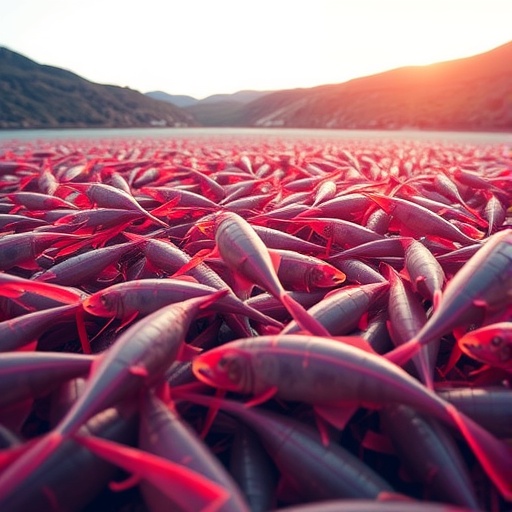In the summer of 2024, northern Norway experienced a profound marine heatwave that was subsequently linked to an alarming outbreak of salmon lice. This unprecedented ecological event is reshaping conversations around climate variability and its direct impact on marine ecosystems. The findings from a recent study authored by Gonzalez, Sandvik, and Jensen et al. shed crucial light on the intricate interplay of factors that contributed to this alarming phenomenon. As scientists delve deeper, the implications for both marine life and the fishing industry become increasingly significant.
The study underscores that the marine heatwave, a prolonged increase in sea surface temperatures, aligns closely with notable changes in climate patterns. Researchers meticulously examined temperature datasets to confirm that the summer of 2024 witnessed temperatures substantially exceeding historical averages. These anomalies may have been exacerbated by larger, global climatic shifts, such as El Niño, which is well-documented for its capability to alter weather patterns and oceanic temperatures.
Intriguingly, the data suggests that the heatwave was not a standalone event but rather intertwined with broader climatic trends. For example, the researchers observed that preceding years were characterized by a gradual increase in sea surface temperatures, setting the stage for the extreme heat conditions of 2024. This slow build-up of warmth can be critical in a marine context, where species acclimatization may be insufficient to cope with sudden temperature spikes.
One striking outcome of the heatwave was the skyrocketing population of salmon lice, a parasitic organism that thrives in warm waters. As the study highlighted, the warmer temperatures provided ideal conditions for the proliferation of these parasites. Salmon lice can have devastating effects on salmon populations, which are economically and ecologically important to the region. The outbreak can seriously jeopardize fish health, leading to reduced yields for fishing industries already challenged by fluctuating environmental conditions.
In addressing the ecological balance, the researchers emphasized the cascading effects that arise from the increased lice population. Higher instances of parasitism can weaken fish populations, resulting in a shift in predator-prey dynamics within marine ecosystems. This disruption may prompt immediate responses from various marine species, leading to unanticipated consequences that ripple through food webs and alter community structures.
Moreover, the implications of these findings extend beyond local fish populations to broader implications for regional fisheries management. As the conditions for lice outbreaks become more favorable under climate change scenarios, fisheries must adapt to these new realities. This may involve implementing more stringent monitoring and management strategies or even re-evaluating traditional practices that could exacerbate the impact of lice infestations.
The research also prompts a compelling dialogue about adaptation strategies within an industry facing the dual pressures of climate change and biological threats. Stakeholders are increasingly urged to collaborate on developing resilient practices and innovation in aquaculture technologies that might mitigate the risks associated with rising temperatures and infestations.
Public awareness of these ecological changes is essential, as the interplay between climate change and marine health not only holds ecological importance but also socioeconomic implications. Communities reliant on fishing industries must be prepared for shifts in catches and species distributions, making it critical for local governments and organizations to engage in proactive planning and education.
In conclusion, the summer heatwave and the resulting surge in salmon lice underscore the urgent need to address climate change’s multifaceted impacts on marine ecosystems. Researchers like Gonzalez, Sandvik, and Jensen et al. are paving the way toward a greater understanding of these phenomena, advocating for tailored policies and actions that will safeguard marine resources for future generations. The world is witnessing a turning tide, one that reveals the fragility of our oceans and the necessity for concerted efforts in ecological stewardship and climate action.
As we continue to analyze the ramifications of these recent events, the perspective offered by scientific research becomes more critical than ever. The challenges that lie ahead should motivate us to foster a deeper appreciation of the delicate balance that sustains marine ecosystems, ultimately driving home the point that active stewardship of our environment is essential for ensuring the viability of both species and industries connected to the sea.
In highlighting the broader implications of the summer 2024 marine heatwave and the salmon lice outbreak, we are reminded that our actions today will determine the health of our oceans tomorrow. Engaging with this research not only enlightens us about the intricate complexities of marine science but also reaffirms the urgent necessity for adaptive management strategies in the face of climate change. The ocean’s future, and indeed our own, depends on the decisions we make now.
Thus, the intricate correlation between climate phenomena and marine health issues calls for a multifaceted approach to address the impending challenges. Insights drawn from studies like those of Gonzalez, Sandvik, and Jensen pave the way for understanding the urgency behind these environmental warnings. As the scientific community continues to elucidate these dynamics, it becomes increasingly plausible to envision a more resilient marine environment capable of adapting to the ever-evolving challenges posed by climate change.
Subject of Research: Impact of marine heatwaves and salmon lice outbreaks on northern Norway.
Article Title: Drivers of the summer 2024 marine heatwave and record salmon lice outbreak in northern Norway.
Article References:
Gonzalez, S., Sandvik, A.D., Jensen, M.F. et al. Drivers of the summer 2024 marine heatwave and record salmon lice outbreak in northern Norway.
Commun Earth Environ 6, 639 (2025). https://doi.org/10.1038/s43247-025-02618-1
Image Credits: AI Generated
DOI:
Keywords: marine heatwave, salmon lice, climate change, northern Norway, ecological impact, fisheries management.




